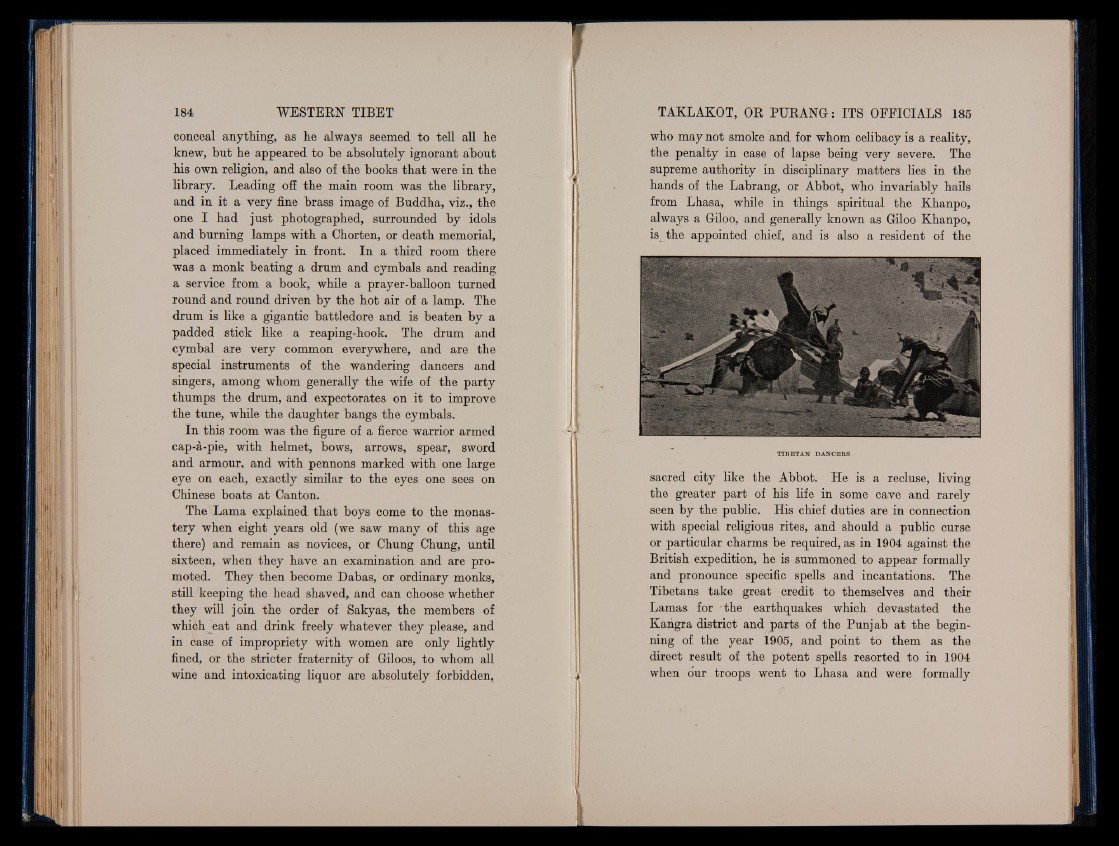
conceal anything, as he always seemed to tell all he
knew, but he appeared to be absolutely ignorant about
his own religion, and also of the books that were in the
library. Leading off the main room was the library,
and in it a very fine brass image of Buddha, viz., the
one I had just photographed, surrounded by idols
and burning lamps with a Chorten, or death memorial,
placed immediately in front. In a third room there
was a monk beating a drum and cymbals and reading
a service from a book, while a prayer-balloon turned
round and round driven by the hot air of a lamp. The
drum is like a gigantic battledore and is beaten by a
padded stick like a reaping-hook. The drum and
cymbal are very common everywhere, and are the
special instruments of the wandering dancers and
singers, among whom generally the wife of the party
thumps the drum, and expectorates on it to improve
the tune, while the daughter bangs the cymbals.
In this room was the figure of a fierce warrior armed
cap-a-pie, with helmet, bows, arrows, spear, sword
and armour, and with pennons marked with one large
eye on each, exactly similar to the eyes one sees on
Chinese boats at Canton.
The Lama explained that boys come to the monastery
when eight years old (we saw many of this age
there) and remain as novices, or Chung Chung, until
sixteen, when they have an examination and are promoted.
They then become Dabas, or ordinary monks,
still keeping the head shaved, and can choose whether
they will join the order of Sakyas, the members of
which eat and drink freely whatever they please, and
in case of impropriety with women are only lightly
fined, or the stricter fraternity of Giloos, to whom all
wine and intoxicating liquor are absolutely forbidden,
who may not smoke and for whom celibacy is a reality,
the penalty in case of lapse being very severe. The
supreme authority in disciplinary matters lies in the
hands of the Labrang, or Abbot, who invariably hails
from Lhasa, while in things spiritual the Khanpo,
always a Giloo, and generally known as Giloo Khanpo,
is the appointed chief, and is also a resident of the
KfaBraar- N
W M ü
M p r ijtt
TIBETAN DANCERS
sacred city like the Abbot. He is a recluse, living
the greater part of his life in some cave and rarely
seen by the public. His chief duties are in connection
with special religious rites, and should a public curse
or particular charms be required, as in 1904 against the
British expedition, he is summoned to appear formally
and pronounce specific spells and incantations. The
Tibetans take great credit to themselves and their
Lamas for the earthquakes which devastated the
Karigra district and parts of the Punjab at the beginning
of the year 1905, and point to them as the
direct result of the potent spells resorted to in 1904
when our troops went to Lhasa and were formally